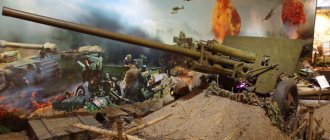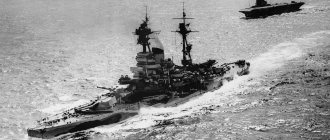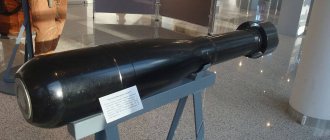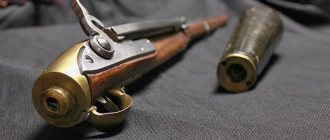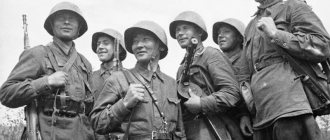German Mauser Karabiner 98k The German Mauser 98k rifle became the main and most popular small arms of Nazi Germany in World War II. It was a shortened version of the Mauser repeating rifle of the 1898 model with very minor design changes. The letter "k" at the end of the name was an abbreviation for the German word "Kurz" ("short"). The Mauser 98k rifle also had the names Karabiner 98k, Kar98k and K98k.
Despite the reduced stock and barrel length parameters relative to a standard rifle, in German terms of that time, “carbines” primarily meant the suitability of this weapon (primarily the mounts) for cavalrymen. At the same time, in terms of its weight and size parameters, the Mauser 98k is quite comparable to full-fledged rifles.
This situation arose as a result of the terms of the Treaty of Versailles, according to which Germany, defeated in World War I, was prohibited from having rifles in the army's arsenal. However, the Germans renamed the Mauser Gewehr 98 rifles available to the army into Karabiner 98b carbines, implementing a number of minor design changes. The bend of the bolt handle, sighting devices, and method of attaching the belt were changed, which in general did not affect the properties of the weapon itself.
History of appearance
By the end of the 19th century, the German arms company of the Mauser brothers was considered one of the world's leading developers and suppliers of small arms. The successful design of the classic Gever rifles from 1871-1888 was repeatedly modernized, until in the spring of 1895 Wilhelm and Paul Mauser combined a number of the most effective solutions into a new type of weapon, patented for the 7.92x57 mm cartridge, perfect for its time.
In 1898, this new Mauser repeating rifle was adopted by the army of the German Empire under the designation Mauser Gewehr 98 (also G98 or Gew.98). This rifle was not particularly popular: exactly half a million of its copies were produced in Germany. Since 1905, the original version of the Gewehr 98 has changed slightly due to the adoption of a 7.92 mm caliber cartridge with a pointed bullet instead of a blunt one. Since such a bullet had much better ballistics, the rifles were equipped with new sights, re-calibrated for a longer-range cartridge.
Carbines were also produced based on the Mauser Gewehr 98: first the Kar.98, and from the early 1920s the Kar.98a. The next modification occurred in 1935. It was then that the rifle under the designation Mauser Karabiner 98 kurz was adopted by the German Wehrmacht as the main individual weapon not only for cavalry, but also for infantry. The improvements were expressed in a new mounting scheme for the rifle belt, as well as in a sighting device of the “front sight in the front sight” type.
This version of the rifle was destined to become the most popular. During the Second World War, the Mauser 98k was produced by the industry of Germany and the countries it occupied (Austria, Poland, Czechoslovakia). Until 1945, over 14 million units of these weapons were produced. After the end of the war, many Mauser rifles found their way into various civilian arms markets, where they are still sold today. An illustrative example of this kind is the Russian KO-98 hunting carbines that appeared already in the 2000s, which are captured Mausers re-barreled for the 7.62x51 mm cartridge.
German cavalrymen with Mausers in training before World War II
Circulations
The prevalence of both rifles was colossal.
There are dozens of countries where Mosin and Mauser rifles were in service, so we will compare production runs. And here the simple and reliable Russian rifle is the undisputed leader. The 14 million K98s produced cannot be compared to the 37 million Mosinki. Yes, the production of Mausers was curtailed after the defeat of the Reich in 1945, and the competitor was produced until 1965. But the middle of the century is already a transition to self-loading and automatic systems, that is, the time of Kalashnikov assault rifles. So it is unlikely that these 20 years had any radical impact on the number of rifles produced.
Image: George H. Mewes / wikipedia.org
Performance characteristics
| Options | Values | |
| Mauser 98 | Mauser 98k | |
| Weight without cartridges | 4.1 kg | 3.9 kg |
| Weapon length | 1250 mm | 1100 mm |
| Rifle length with bayonet | 1500 mm | 1340 mm |
| Barrel length | 740 mm | 600 mm |
| Initial bullet speed | 878 m/s | 760 m/s |
| Sighting range | 2000 m | 1500 m |
The Mauser 98k rifle was equipped with an integral double-row magazine with a staggered arrangement of 5 rounds. The practical rate of fire of this weapon was estimated at 15 rounds per minute. Some other bolt action rifles, notably the British Lee-Enfield, had a higher rate of fire.
Length
Let’s say right away: we will not compare such indicators as the sighting range and “destructive power” - simply because both rifles have both the range and the muzzle energy of the cartridge obviously higher than what is required in a real battle. Yes, you can shoot from a Mosinka not at 1500, but at 2000 meters, but we understand perfectly well that at such a distance a person with a rifle will not hit anywhere. The actual combat distances in both the First World War and the Great Patriotic War were up to 500 meters maximum. That is why humanity has rearmed itself with machine guns and intermediate cartridges.
Hence, by the way, the first advantage of the Mauser over the Mosin rifle - it is simply shorter. The total length of the K98, even with a bayonet, is only 1.25 meters (and without it, even 1.1 meters) - while the three-ruler, even without a bayonet, is 1.234 m, and with it - more than 1.6 meters. In a cramped trench, in the back of a truck, indoors, a short carbine is much more convenient than a long rifle. The latter, due to the length of the barrel, gives a greater flatness of trajectory and effective range - but, as we have already found out, this is not a particularly important parameter for modern wars. The Red Army's own short carbine appeared in commercial quantities only in 1944.
Design Features
By its design, the Mauser 98k is a repeating rifle with a sliding bolt that rotates when locked. The bolt has three lugs, two of which are located in its front part and one in the rear. It locks by turning 90 degrees. The charging handle is located on the rear of the bolt.
The bolt has gas outlet holes, which, when gases break through from the cartridge case, remove the powder gases back through the hole for the striker down into the magazine cavity. The bolt is held in the receiver by a locking mechanism and can be removed from the rifle without the aid of tools. This operation requires placing the safety in the middle position, as well as pulling back the front of the lock and then removing the bolt.
The Mauser's safety is on and the bolt is locked.
The design feature of the famous “Mauser” bolt is a massive non-rotating ejector, which captures the rim of the cartridge in the process of removing it from the magazine and rigidly holds the cartridge on the bolt mirror. This system, together with a short longitudinal displacement of the bolt back when opening it, ensures reliable extraction of even very tightly seated cartridges in the chamber. The cartridge case is ejected from the receiver by an ejector mounted on the left wall of the receiver and passing through a longitudinal groove in the bolt.
The Mauser 98k rifle's magazine is completely hidden in the stock. Loading is done from clips or one cartridge at a time, but this is not allowed directly into the chamber, as it can lead to breakage of the ejector tooth.
The trigger mechanism is striker type, the trigger travel is with a warning. Cocking the firing pin and arming the weapon is done by turning the handle when opening the bolt. The condition of the firing pin can be easily determined visually or by touch by the position of the shank protruding from the bolt.
The fuse is a three-position, reversible one, located in the rear of the bolt. Has the following provisions:
- Horizontally to the left - “safety is on, shutter is locked”;
- Vertically up - “safety on, bolt free”;
- Horizontally to the right - “fire”.
The safety "up" position is used to load and unload the weapon, as well as to remove the bolt. Operating the safety is simple and easy to use with your right thumb.
The standard Mauser 98k rifle has a sector sight consisting of a sighting block, a sighting bar (with graduations corresponding to a change in range of 100 meters) and a clamp with a latch. The front sight (usually covered by a semicircular removable front sight) is attached to the base of the muzzle of the barrel in a dovetail groove with the possibility of making lateral adjustments. The adjustable rear sight is located on the barrel in front of the receiver.
The stock is wooden, with a semi-pistol grip. The butt plate is steel, with a door that closes the cavity for storing accessories. The cleaning rod is located in the front part of the stock under the barrel; for cleaning the weapon, it is assembled from two halves.
In general, the design of the Mauser 98k is almost similar to that of the Mauser 98. In addition to a shorter barrel, the 98k version is distinguished by:
- Slightly reduced length of the stock and the presence of a recess in it for a downward-curved bolt handle;
- Ejecting the clip after loading the magazine with cartridges by moving the bolt (previously the clip had to be removed manually);
- When the cartridges from the magazine are used up, the feeder does not allow the bolt to close, which serves as a signal to the shooter to fill the magazine.
The SG 84/98 bayonet with
Mauser 98k sheath was equipped with standard SG 84/98 blade-type bayonets, which were significantly shorter and lighter than the bayonets of conventional Mauser 98. This bayonet had a blade 25 cm long with a total length of 38.5 cm. For wear on the waist The belt bayonet was placed in a special sheath. Since the end of 1944, in order to save money, German rifles were no longer equipped with bayonets and knives, and at the same time the mount for them was removed. This version, called Kriegsmodell (“military model”), also lost the metal disc in the butt, and instead of walnut wood, plywood was used to make the stock, but this did not affect the shooting characteristics of the weapon.
Notes
- ↑
- , With. 251-252.
- Popenker M.R., Milchev M.N. World War II: The Gunsmiths' War. M.: Yauza, Eksmo, 2008. p. 193
- ↑ Popenker M.R., Milchev M.N. World War II: The Gunsmiths' War. M.: Yauza, Eksmo, 2008. p. 194
- , № 11.
- ↑ “Mauser Bolt Rifles by Ludwig Olsen, 3rd edition, F. Brownell and Son, Publisher, p. 126
- ↑ Bishop, Chris. Guns in Combat
. Chartwell Books, Inc (1998). ISBN 0-7858-0844-2. - ↑ Brassey's Infantry Weapons of the World, 1950-1975, J. I. H. Owen (1975), p. 57
- Axworthy, Mark W. (2002), Axis Slovakia: Hitler's Slavic Wedge 1938-1945, Europe Books Inc., ISBN 1-891227-41-6
- McNab, Chris.
20th Century Military Uniforms. — 2nd. - Kent: Grange Books, 2002. - ISBN 1-84013-476-3.
Analogs of rifles in the USSR
A common comparison between the German Mauser 98K carbine and its Soviet counterpart is the 1891/1930 7.62mm Mosin rifle, known as the "three-line". These rifles were the most common individual small arms of the infantry of Germany and the USSR during the Great Patriotic War.
Both of these rifles were distinguished by their relative simplicity and safety in handling, as well as their high reliability and durability, although the service life and structural strength of the Mauser were rated slightly higher. The advantages of the German Mauser 98k over the Mosin rifle include:
- Shorter overall length of the weapon;
- Higher rate of fire;
- Smoother shutter travel.
The Soviet “three-ruler” is considered more efficient in reloading due to the straight handle, which also has a more convenient location. In addition, the Mosin rifle was less demanding in terms of manufacturing technology, which contributed to the noticeably lower cost of its mass production.
German snipers clean their weapons and equipment between battles
Rifle grenade launchers
But in terms of rifle grenade launchers, the Wehrmacht was certainly superior to the Red Army. The Dyakonov grenade launcher mounted on the Mosin rifle was downright terrible. The entire range of grenades that he could fire were approximately equally bad, and he did not gain any popularity among the fighters.
But the German one, which was installed on the K98, performed excellently. Almost one and a half million were released, soldiers used them to fight infantry, tanks, set up smoke screens and spent hundreds of thousands of grenades a month. This is a clear indicator of success. The Germans are in the lead in the “grenade launcher” component.
Soldier armed with K98 with Gewehrgranatgerät. Photo: wikipedia.org
Combat use
Mauser 98K rifles were widely used by all branches of the German armed forces during World War II. They were used in all theaters of military operations involving German troops, including Europe, North Africa, and the territories of the Soviet Union. As an individual small arms infantry weapon, the Mauser, for all its positive qualities, was relatively cumbersome and inconvenient for combat at close ranges.
The rate of fire from the Mauser 98k was limited by how quickly the shooter could operate the bolt and load the magazine, the small capacity of which significantly reduced firepower. During the same period, the armed forces of Germany's main enemies received self-loading rifles that had a significantly higher rate of fire: the United States massively supplied its army with M1 Garand rifles, and Soviet troops received the SVT-40.
The Germans at the beginning of the war relied more on single MG-34 machine guns for firepower, as well as on the use of Wehrmacht units armed with MP-38 and MP-40 submachine guns. Self-loading rifles began to be produced later, but the Gewehr 43 was not very successful, and the Sturmgewehr 44 could no longer be produced in sufficient quantities. As a result, the Mauser 98K was produced until the last days of the war, remaining the main weapon of the Wehrmacht.
Additional accessories
During World War II, several additional devices were adopted for the Mauser 98k rifle, which significantly expanded the combat capabilities of this weapon.
The main ones:
- The standard Gewehrgranat Geraet 42 rifle grenade launcher was attached to the barrel using a folding clamp. The maximum firing range from it was up to 250 meters. 7 different types of grenades were used as special ammunition;
- The GG/P40 (Gewehrgranatgeraet zur Panzerbekämpfung 40) anti-tank grenade launcher was developed for paratroopers and produced in a small batch. It was lighter and smaller than the standard GG 42 and was attached to the rifle like a bayonet;
- Winter trigger (German: Winterabzug) is a device designed to make rifle shooting easier in winter. Developed in 1942, officially adopted in 1944. It was widely used by snipers because it allowed them to shoot in winter without taking off their gloves. The “winter trigger” was a tin container with a lever inside that fit onto the trigger safety guard. By turning the outer trigger back, the shooter carried out the descent. A similar device was used on the MP 40 submachine gun;
- Silencers. Two types of them have become famous: 23 and 25.5 cm long with a spiral surface. They were put on the barrel using a clamp, similar to the mount for a barrel grenade launcher;
- Krummlauf - a device for shooting from behind cover, capable of turning the bullet's travel by 30 degrees. It was attached to the rifle barrel using the same mechanism as the barrel grenade launcher. Developed in 1943, but after the production of several prototypes, they then tried to adapt them to new assault rifles.
Karabiner 98k sniper with ZF4 scope and winter trigger
Sniper use
The Wehrmacht used standard Mauser 98K rifles as snipers. During factory tests, specimens that gave maximum accuracy were selected from the batch, as was done during the First World War (with conventional Mauser 98 rifles). In addition, SmE (Spitzgeschoss mit Eisenkern, a pointed bullet with a steel core) cartridges were used for sniper shooting.
The first telescopic sight officially adopted by the Wehrmacht was the ZF 39 (Zielfemrohr 1939). In 1940, this sight received a standard graduation for a distance of up to 1200 meters. It was installed above the bolt; during the war, the mounting design was repeatedly improved.
In the summer of 1941, the ZF 41 sight, also known as the ZF 40 and ZF 41/1, was adopted, and at the end of the same year, Mauser 98k carbines equipped with it began to enter the army. With a length of 13 cm, it provided only one and a half times magnification; it was attached to the left side of the rear sight, so it did not interfere with loading the magazine from the clip. Such a sight could only be used for medium-range shooting, and Mausers equipped with it were considered a “rifle for high-precision shooting,” and not snipers. Their production continued until the end of the war.
The ZF 4 telescopic sight (or ZF 43, ZFK 43 and ZFK 43/1) was originally intended for the G43 semi-automatic rifle and was a copy of the Soviet sight, which ultimately had to be adapted to the K98k rifle. The sight was placed above the bolt on an arrow-shaped mount, which was produced in a fairly limited series at the very end of the war.
Other types of sights were used on the Mauser 98k, including Opticotechna, Dialytan and Hensoldt & Soehne 4x telescopic sights, and the rare Carl Zeiss Jena Zielsechs 6x telescopic sight. According to rough estimates, about 200 thousand Mauser 98K carbines were equipped with various optical sights, but no more than a tenth of them can be classified as “sniper” in terms of characteristics.
Notes
- see this article in English and German
- , With. 587: “During the First World War, Tsarist Russia lacked small arms, so in addition to Russian-style rifles, the army also had foreign ones - Japanese Arisaka mod. and years, Austro-Hungarian Mannlicher 1889 and years, German “88” and “98”. In addition to these rifles, obsolete models were also used, firing cartridges filled with black powder - Berdan No. 2 model 1870, Gra 1874, Gra-1874/85, Vetterli 1870/87.”
- Alexander Bortsov. Cartridges of Finland // magazine “Master Gun”, No. 4 (121), April 2007. pp. 60-65
- Alexander Bortsov. Cartridges of Czechoslovakia // magazine “Master Gun”, No. 11 (116), November 2006. pp. 62-67
Advantages and disadvantages
Among the main advantages of the Mauser 98k rifle, experts indicate:
- High muzzle energy, providing good penetration and lethal effect of the bullet;
- Successful shutter design, contributing to high reliability and smooth operation;
- Stopping the bolt in the rear position warns the shooter about the need to load the weapon and eliminates attempts to fire from an unloaded weapon;
- The magazine hidden in the stock is protected from mechanical damage.
The disadvantages of the Mauser 98k include:
- Small magazine capacity;
- Considerable weight of the rifle;
- Strong recoil;
- A sharp and loud sound of a shot.
In general, the Mauser system of the 1898 model, as well as its further development - Karabiner 98 Kurz, are considered one of the most successful solutions in its class. This design has proven its strength, long service life, simplicity and safety in handling. Despite the significant complexity of the production technology, the Mauser system became the basis for many different types of military and hunting rifles and carbines.
Mauser 98k operating countries
- People's Republic of China
- Republic of China
- Croatia
- Czechoslovakia (after 1945)
- Denmark
- German Democratic Republic
- Finland (Bought from the Germans. Mainly used in conjunction with a grenade launcher for a rifle)
- France
- Germany
- Indonesia: The Indonesians used K 98k captured from Dutch forces during the Indonesian War of Independence.
- Israel
- Luxembourg. The Grand Duke's Guard used K98k taken from German troops in 1945, later changed to Ross rifles in the same year
- Malaysia
- Third Reich
- Norway
- Netherlands Used after the end of World War II
- Portugal
- San Marino
- Serbia
- Slovakia
- Sweden. In 1939, Sweden received 5,000 Kar 98k rifles
- Türkiye
- Yugoslavia
- Pakistan (after 1945)
- Poland
- Ethiopia. Ethiopian patriots used captured rifles against Axis forces from 1941
- Various formations around the world.
Non-state actors
Korean Liberation Army (a group of guerrilla forces that fought for Korean independence during the Japanese occupation)
Reliability
Here the Mauser is somewhat more sensitive to frost and dirt. But only “a few” - you shouldn’t believe the stories that “the Germans couldn’t shoot in winter due to lack of winter lubricant.”
The Mosin rifle is still more reliable. True, in conditions of low culture of handling weapons, even such a simple and unpretentious system can be ruined. For example, during the First World War there were many cases when the magazine of a rifle was tightly clogged with dirt, and the soldiers were in no hurry to clean it out - they used the weapon as a single-shot one. If you don’t take care of your weapon, both models are simply phenomenal in reliability.
Manufacturers
Mauser 98k was produced by the following companies:
Mauser Werke AG, plant in Oberndorf am Neckar;
Mauser Werke AG, plant in Borsigwald, a suburb of Berlin;
JP Sauer und Sohn Gewehrfabrik, Suhl plant;
Erfurter Maschinenfabrik (ERMA) (English), plant in Erfurt;
Berlin-Lübecker Maschinenfabrik, plant in Lübeck;
Berlin-Suhler-Waffen und Fahrzuegerke;
Gustloff Werke, plant in Weimar;
Steyr-Daimler-Puch AG, plant in Steyr (Austria);
Steyr-Daimler-Puch AG, workshops in the Mauthausen concentration camp (Austria);
Waffen Werke Brunn AG, plant in Povazska Bistrica (Slovakia).
Bayonet
Let's take a closer look at the bayonets. The Mosin rifle is equipped with a classic needle bayonet. And the Mauser is attached to a bayonet-knife, which, as the name implies, is both a bayonet and a knife, so that it can not only fight in close combat, but also do a lot of things in everyday life, for example, cutting sausage. By the way, according to the widespread version, at the beginning of the 20th century, “mosinki” were not equipped with bayonets-knives for fear that economic soldiers from the peasants would immediately steal them and send them home - and no one would be flattered by the needle ones (as, indeed, it happened).
Bayonet for Mauser 98k. Photo: wikipedia.org
True, the Germans also did not really want bayonets to be used for other purposes. Therefore, they were made of steel, which held an edge very poorly - so they made disgusting knives. As for the combat qualities of bayonets, they turned out to be as superfluous in the Great Patriotic War as the huge sighting range: the percentage of losses from bayonet attacks was very small. It got to the point that since 1944 they stopped putting bayonets on Mauser carbines altogether. Therefore, the “bayonet” advantage of the German rifle, if it exists, is very small.
Optics
Both the Mosin rifle and the Mauser carbine were used as “specialized” options. First of all, they were used as snipers, installing optical sights. And here the apparent superiority of the German rifle with its Zeiss optics turns out to be not at all obvious. As military historian Andrei Ulanov said, Soviet PU and PE sights, created back in the thirties on the basis of German ones, were at least no worse - they gave an increase of 3.5 - 4 times. And most of the German sights that were installed on Mausers were only 1.5x. The captured rifles with such sights after testing did not impress the Soviet officers. Here the championship belongs to the “Mosinka”.
Ammo
Many people have complaints about the outdated Russian rimmed 7.62x54 cartridge. However, most of the problems relate to its use not in rifles, but in machine guns. Such a cartridge is not a hindrance for the Mosinka; the only drawback is the slightly larger dimensions of the magazine, which protrudes beyond the stock. The Mauser does not have this drawback, because more rationally made cartridges allow the magazine to be double-rowed.
7.62x54R mm cartridges in assortment (late modification with pointed bullets, initially the bullets had round toes). Image: CynicalMe / wikipedia.org
Both rifles are loaded from clips of five rounds (although only four are placed in the Mosinki magazine, the fifth goes straight into the barrel - which is why many people mistakenly consider the rifle to be a five-round rifle). With the Mauser, all cartridges go straight into the magazine; it is strictly not recommended to put a sixth cartridge into the barrel: the extractor may break. In this regard, by the way, the Mosin rifle is somewhat ahead: if necessary, you can quickly load one cartridge into the barrel and immediately shoot without fear of damaging the rifle.
In addition, German weapons are much more convenient to load from a clip. But if the cartridge is jammed and the rifle needs to be unloaded, then the German carbine does not allow you to do this quickly. But with the Mosinka there are no such problems.
